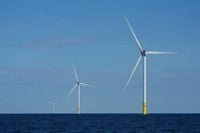If Americans think their energy bills are steep now, they might want to brace themselves for what’s coming down the line. According to a recent analysis by GOBankingRates, households across the country should expect their utility costs—especially electricity—to climb even higher throughout the second half of 2025 and into 2026. This comes amid a swirl of political debate and industry upheaval, as the nation’s energy sector faces both surging demand and mounting uncertainty over the future of renewables.
“Over the past year alone, [electricity prices] are up 5.5%, more than twice the rate of overall inflation,” Owen Quinlan, head of data for Arbor, told GOBankingRates, citing figures from the Federal Reserve and Bureau of Labor Statistics. Since 2004, electricity costs have soared more than 111%, outpacing rent and grocery price hikes. The reasons? A perfect storm of new demand—think artificial intelligence data centers, electric vehicle charging stations, and record-breaking summer heat—has put unprecedented strain on the nation’s power grid.
But it’s not just the rising demand that’s causing headaches. Quinlan argues that the way energy resources are allocated is “punishing households and small businesses while letting large industrial users avoid the worst of it.” He added, “Our grid isn’t failing because we don’t have enough energy. It’s failing because we aren’t using the energy we have smartly.”
For many Americans, the reality is simple: you can’t cancel your power bill. “Electricity is the standout risk for the second half of 2025 and into 2026,” Quinlan said. Unlike streaming services or other discretionary expenses, electricity is a necessity, and its affordability is increasingly threatened by both long-term upward price pressure and sudden spikes due to heatwaves, supply crunches, or market fluctuations.
Yet, as daunting as these trends may be, experts point out that there are still ways for consumers to minimize the damage. Paul Hines, vice president of power systems at EnergyHub, emphasized that “energy efficiency remains one of the most impactful and accessible strategies homeowners can use to take control of their utility bills.” Upgrades like better insulation, high-efficiency appliances, and LED lighting can help trim a home’s baseline energy use and, over time, lower costs.
For those living in deregulated states, Quinlan advises checking whether your electricity plan is variable or fixed. “If it changes month to month, you are likely on a variable plan and could lock in a better fixed rate,” he explained. The difference can be dramatic—he’s seen customers pay as much as 50 to 60 cents per kilowatt-hour, while the national average hovers around 10 cents. On a 1,000 kWh bill, that’s a $400 difference. In regulated states, customers should ask their utility about cost-effective plans like time-of-use pricing, which rewards shifting energy use to off-peak hours.
Community solar subscriptions are another option, especially in states that participate in such programs. “You can subscribe to a share of a solar farm and receive credits on your bill, often guaranteeing 5% to 10% monthly savings without installing anything,” Quinlan said. For those willing to invest up front, pairing energy consumption shifts with smart technologies—such as smart thermostats, batteries, and automated energy management systems—can “supercharge” savings, Hines explained. These tools help optimize when and how energy is used, ultimately reducing costs.
But the conversation about America’s energy future isn’t just happening at the kitchen table—it’s raging in the halls of power, too. On August 22, 2025, the Bureau of Ocean Energy Management (BOEM) issued an order halting construction on the Revolution Wind offshore wind project near Rhode Island, citing unspecified national security concerns. The decision sent shockwaves through the industry and drew sharp criticism from state leaders and renewable energy advocates.
The Revolution Wind project, spearheaded by Danish developer Orsted, was already about 80% complete, with 45 out of 65 turbines installed. Construction began in 2023, and the project was slated to be fully operational in 2026, providing enough power for over 350,000 homes in Rhode Island and Connecticut—states with little available land for large-scale energy projects. Rhode Island Governor Dan McKee and Connecticut Governor Ned Lamont, both Democrats, vowed to “pursue every avenue to reverse the decision to halt work on Revolution Wind,” as McKee posted on X. Connecticut Senator Richard Blumenthal called the move a “major setback,” noting that the project had already employed hundreds of skilled workers.
The White House’s stance on renewables has grown increasingly antagonistic. President Donald Trump, in an August 2025 post on his Truth Social platform, declared wind and solar power “THE SCAM OF THE CENTURY!” and promised not to approve new wind or “farmer destroying Solar” projects. “The days of stupidity are over in the USA!!!” he wrote. This isn’t the first time the administration has stepped in to halt offshore wind: work was previously stopped on New York’s Empire Wind project, only to resume after political intervention from Senator Chuck Schumer and Governor Kathy Hochul.
Industry insiders say the sector is facing a perfect storm. On August 23, 2025, Bloomberg reported that the offshore wind industry is reeling from not just political headwinds, but also rising costs and fierce competition from Chinese manufacturers. Orsted announced a capital increase, and TPI Composites—a major supplier—declared bankruptcy within hours, sending shockwaves through wind energy investors. “The industry struggles amid increasing costs and political opposition from the Trump administration,” Bloomberg noted.
Wind power is currently the largest source of renewable energy in the U.S., accounting for about 10% of the nation’s electricity generation. But with only one fully operational large-scale offshore wind project producing power, many experts argue that more—much more—is needed to meet America’s rising energy needs and climate goals. “Today, the U.S. has only one fully operational large-scale offshore wind project producing power. That is not enough to meet America’s rising energy needs. We need more energy of all types, including oil and gas, wind, and new and emerging technologies,” said Erik Milito, president of the National Ocean Industries Association, as reported by the Associated Press.
Not everyone is mourning the Revolution Wind halt, however. Green Oceans, a nonprofit that opposes the offshore wind industry, applauded the BOEM’s decision, stating, “We are grateful that the Trump Administration and the federal government are taking meaningful action to preserve the fragile ocean environment off the coasts of Rhode Island and Massachusetts.”
Meanwhile, critics argue that the administration is “trying to prop up clunky, polluting coal plants while doing all it can to halt the fastest growing energy sources of the future – solar and wind power,” as Kit Kennedy of the Natural Resources Defense Council put it. “Unfortunately, every American is paying the price for these misguided decisions.”
Back on the home front, experts urge consumers not to overlook the small stuff. Everyday “energy vampires”—electronics and appliances that draw power even when turned off—can add up. “Simple actions like unplugging unused devices or using smart power strips can help eliminate that hidden load and amplify your overall efficiency gains,” Hines said. And while many federal tax credits for energy efficiency are phasing out, local utilities often still offer rebates and incentives to make energy-smart technologies more affordable.
As the debate over America’s energy future intensifies, one thing is clear: rising costs and policy battles aren’t just abstract issues—they’re hitting families and businesses right where it hurts. Whether the answer lies in smarter consumption, political change, or technological breakthroughs, the stakes have never been higher—or the bills more daunting.





